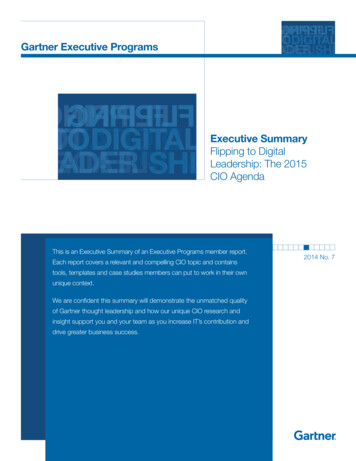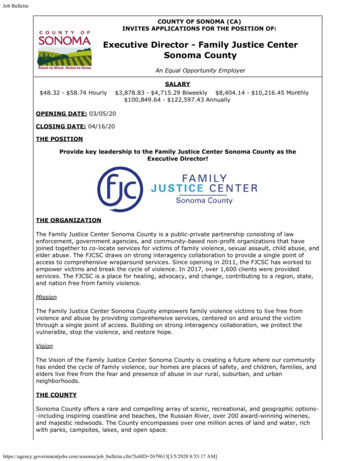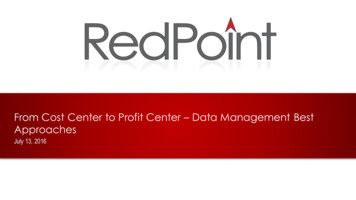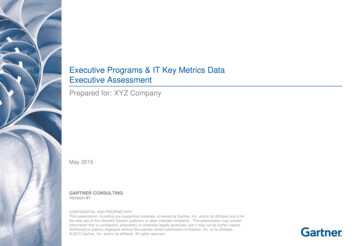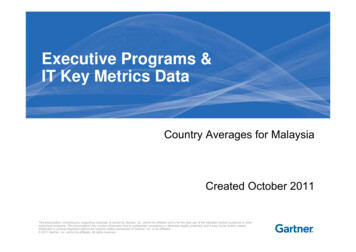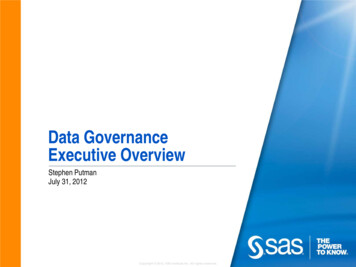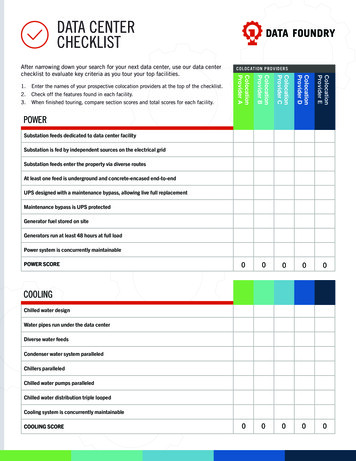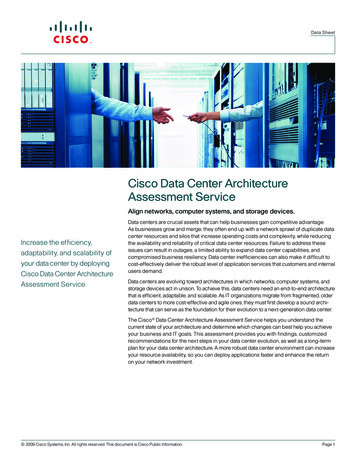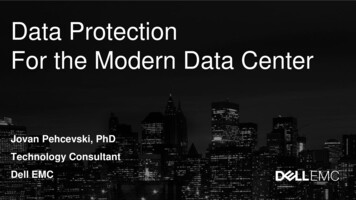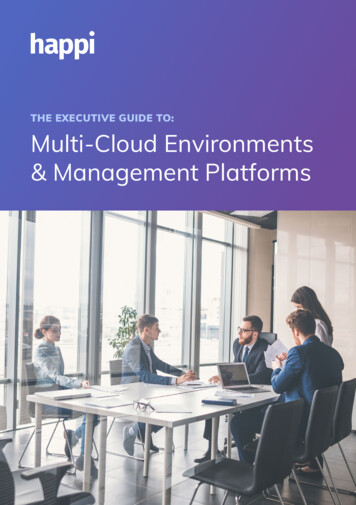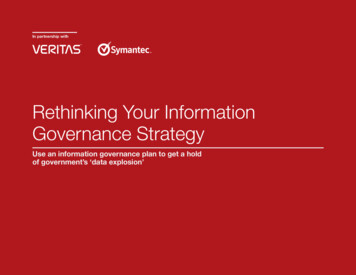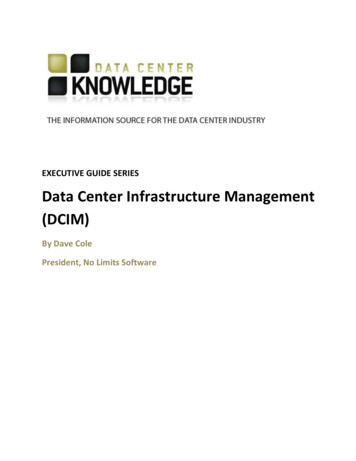
Transcription
EXECUTIVE GUIDE SERIESData Center Infrastructure Management(DCIM)By Dave ColePresident, No Limits Software
Overview of DCIMToday’s data centers are more complex, more interdependent and more critical than ever before. This has led tothe need for more intelligent and automated IT infrastructure management. The tools which enable the data centerteam to effectively and efficiently operate this complex environment have been grouped into a classification ofsolutions known collectively as Data Center Infrastructure Management (DCIM). Gartner defines DCIM as “tools thatmonitor, measure, manage and/or control data center use and energy consumption of all IT-related equipment(such as servers, storage and network switches), and facilities infrastructure components (such as power distributionunits [PDUs] and computer room air conditioners [CRACs]).” Multiple DCIM models have been put forth by analystfirms such as Gartner, Forrester and the 451 Group. While similar in many respects, there are subtle differencesbetween the various views of DCIM.DCIM ModelsIn the Gartner model, the primarycomponents of a DCIM solution are Input,Process and Output. Various sensors andother system feeds (BMS system, userinput, etc.) comprise the input. This rawdata then sent through an analysisprocess to create actionable data – realinformation which can be used to managethe data center. The processed data isthen presented as output to the user,perhaps in the form of a dashboard ortrend graph, and is also used as controldata back into the input component.The 451 Group model breaks down DCIMinto functional blocks, with datacollection at its base. The data is used asinput to the other functional areas,including Asset and Change Management,Environmental Monitoring, Power andEnergy Measuring and Modeling, PowerManagement and IT Service and SystemsManagement. A data management layerintegrates data from the lower layers tofacilitate reporting as well as providinginput to higher level planning, forecastingand optimization layers.
The Forrester model focuses on DCIM as acomponent of the overall data centermanagement architecture. In this model,DCIM interacts with other managementsystems, with DCIM tools providing inputto virtual infrastructure management,workload management tools and theenterprise service desk. In the report PutDCIM Into Your Automation Plans, GalenSchreck says, “The long-term value ofDCIM is tied to a product’s ability tointegrate with other system managementtools or orchestration tools that optimizedata center workloads. The winners willbe those DCIM platforms that achieve wideadoption and forge integration with keymanagement vendors like BMC, CA, HP,IBM, Microsoft, and VMware.While the DCIM models vary in many ways, there are some key similarities found in each:DCIM provides actionable data for data center managementDCIM requires instrumentation in order to gather data center metricsDCIM is not a standalone solution, but is instead a component of a comprehensive data center managementstrategyWhy Do I Need DCIM?There are a number of benefits in implementing a DCIM solution. To illustrate this point, consider the primarycomponents of data center management.PlanningAnalyze data for inputinto planning processTranslate business needs intodata center requirementsPredictiveAnalysisDesignDesign proper infrastructure tomeet data center requirementsInformationCollect data to ensure datacenter is operating as designedMonitoringOperationsConsistent, repeatable processesfor running the data center
In the Design phase, DCIM provides key information in designing the proper infrastructure. Power, cooling andnetwork data at the rack level help to determine the optimum placement of new servers. Without this information,data center managers have to rely on guesswork to make key decisions on how much equipment can be placed intoa rack. Too little equipment strands valuable data center resources (space, power and cooling). Too muchequipment increases the risk of shutdown due to exceeding the available resources.In the Operations phase, DCIM can help to enforce standard processes for operating the data center. Theseconsistent, repeatable processes reduce operator errors which can account for as much as 80% of system outages.In the Monitoring phase, DCIM provides operational data, including environmental data (temperature, humidity, airflow), power data (at the device, rack, zone and data center level), and cooling data. In addition, DCIM may alsoprovide IT data such as server resources (CPU, memory, disk, network). This data can be used to alert managementwhen thresholds are exceeded, reducing the mean time to repair and increasing availability.In the Predictive Analysis phase, DCIM analyzes the key performance indicators from the monitoring phase as keyinput into the planning phase. Capacity planning decisions are made based during this phase. Tracking the usage ofkey resources over time, for example, can provide valuable input to the decision on when to purchase new power orcooling equipment.In the Planning phase, DCIM can be used to analyze “what if” scenarios such as server refreshes, impact ofvirtualization, and equipment moves, adds and changes.If you could summarize DCIM in one word, it would be information. Every facet of data center managementrevolves around having complete and accurate information.DCIM provides the following benefits:Access to accurate, actionable data about the current state and future needs of the data centerStandard procedures for equipment changesSingle source of truth for asset managementBetter predictability for space, power and cooling capacity means increased time to planEnhanced understanding of the present state of the power and cooling infrastructure and environmentincreases the overall availability of the data centerReduced operating cost from energy usage effectiveness and efficiencyIn his report, Datacenter Infrastructure Management Software: Monitoring, Managing and Optimizing theDatacenter, Andy Lawrence summed up the impact of DCIM by saying “We believe it is difficult to achieve the moreadvanced levels of datacenter maturity, or of datacenter effectiveness generally, without extensive use of DCIMsoftware.” He went on to add that “The three main drivers of investment in DCIM software are economics (mainlythrough energy-related savings), improved availability, and improved manageability and flexibility.”One of the primary benefits of DCIM is the ability to answer questions such as the following:1. Where is my data center asset located?2. Where is the best place to place a new server?3. Do I have sufficient space, power, cooling and network connectivity to provide my needs for the next 6months? Next year? Next five years?
4. An event occurred in the data center – what happened, what services are impacted, where should thetechnicians go to resolve the issue?5. Do I have underutilized resources in my data center?6. Will I have enough power or cooling under fault or maintenance conditions?Without the information provided by DCIM, the questions become much more difficult to answer.DCIM MarketThe DCIM market is growing at a rapid pace as data center managers recognize the benefits such a solution couldprovide in helping them to manage their data centers. DCIM vendors have provided anecdotal evidence of thisincreased interest, stating that questions from potential customers at trade shows have progressed from “What isDCIM?” to “Which DCIM solution would be best for addressing my problems?”. There are a number of factors which aredriving the increased interest in DCIM, but there are two primary demand drivers. First, the increased complexity of thedata center architecture, including higher densities and virtualization, has exceeded the capabilities of managingthrough the use of spreadsheets. Second, there are financial pressures, particularly when it comes to the need todecrease energy costs. The drive toward higher efficiency is also being pushed through legislation and industrystandards, including the EPA Energy Star program for data centers and the European Union Code of Conduct.DCIM Market Size (millions)DCIM Market Expansion 2010 - 2015 1,400“The DCIM market wasworth US 245m in annual 1,200revenue in 2010, and it 1,000will grow to 1,247m in 800 6002015 – a growth rate of 40039% a year.” 200 0201020112012201320142015Andy LawrenceSource: 451 ResearchWhen asked about the key topics of interest to data center managers in the Data Center Knowledge audience survey inAugust 2011, DCIM was the newest and fastest rising area of interest at 70%. Based on polling at the December 2011Gartner conference, Jay Pultz reports that “More than 60% of the data center managers that Gartner polled will haveimplemented data center infrastructure management (DCIM) tools at some point in 2013 – with penetration climbing to90% by 2015.” Pultz recommended that data center managers should not wait to begin the DCIM evaluation process.“For clients who have not yet purchased DCIM, evaluate DCIM tools, including pilot testing,” he suggested. He added “Ifthe evaluation is positive, then include operationalizing DCIM in your 2013 budget. Make DCIM a mandatoryrequirement for all major data center builds and refurbishments.”Prior to evaluating DCIM tools, however, it is very important to put together a detailed list of requirements. Since DCIMis intended to provide information, the requirements list should focus on the information you need to manage your datacenter. Based on your specific requirements, one DCIM solution might be a better fit than the others.
DCIM FunctionalityWith more than 100 companies offering some type of DCIM solution, it is difficult to narrow down a defined set offunctional components. There are some common elements found in many of the solutions, however.Asset/Change/Configuration ManagementAsset management is a key component of DCIM. A data center cancontain thousands of assets, from servers, storage and networkdevices to power and cooling infrastructure equipment. Trackingthese assets is an ongoing and often monumental task. A DigitalRealty Trust survey asked data center managers how long could it taketo find a server that has gone down. Only 26% of the respondents saidthey could locate the server within minutes. Only 58% could find theserver within 4 hours and 20% required more than a day. The inabilityto locate equipment in the data center increases the mean time torepair (MTTR) for the equipment and decreases the overall availability.How Long Could It Take to Find a Server?Within aday22%Within 4hours32%Morethan aday20%Withinminutes26%Digital Realty TrustAsset management encompasses more than simply locating a data center asset, however. It also involves knowingdetailed information about the asset’s configuration. Consider a server, for example. It may be powered by one ormore rack power strips. Disconnecting these power sources will shut down the server. The server may be connected toone or more switches or routers. Rerouting these network devices may make the server unreachable. The server mayhost multiple virtual machines. Shutting down the server will disable these virtual machines. Without knowing thedetails of the server configuration, it is very difficult to make reasonable decisions concerning that server and itssupporting infrastructure. Changes to any part of the configuration may render the server – and its associated services –unusable.In order to accurately manage assets and their detailed configurations, we must also manage change. It is estimatedthat change is often the cause of as much as 80% of system downtime and that 80% of mean time to repair (MTTR) isused trying to determine what changed. Change management therefore becomes an important part of a DCIM solution.In the book The Visible Ops Handbook: Implementing ITIL in 4 Practical and Auditable Steps, the authors examined anumber of high performing IT organizations and found that by just looking at the scheduled and authorized changes foran asset (as well as the actual detected changes on the asset) problem managers could recommend a fix to the problemover 80% of the time, with a first fix rate of over 90%. The authors also found that organizations which implementedautomated change auditing were “surprised and alarmed to see how many changes are being made ‘under the radar’.”The ability to track both authorized changes and detected changes – changes made but not necessarily authorized – iskey DCIM functionality which can reduce MTTR and increase overall system availability.Real-Time MonitoringThere are three categories of real-time monitoring systems in the data center:Building Management System (BMS) – A BMS is typically a hardware-based system utilizing Modbus, BACnet,OPC, LonWorks or Simple Network Management Protocol (SNMP) to monitor and control the buildingmechanical and electrical equipment. These are often custom-built systems priced on the number ofindividual data points being monitored (a data point might be the output load on a UPS or the returntemperature on a computer room air conditioner unit). In some cases, the BMS system is extended into thedata center to monitor and control power and cooling equipment.Network Management System (NMS) – An NMS is typically a software-based system utilizing SNMP to monitorthe network devices in the data center. Network devices can usually be auto-discovered, so installation can beautomated to some degree.
Data Center Monitoring System (DCMS) – A DCMS can be hardware-based and/or software-based and is usedto monitor a data center or computer room. Device communication is typically done using SNMP, althoughsome data center monitoring systems can also communicate using Modbus, IPMI or other protocols.There are some important attributes to consider when evaluating the real-time monitoring capabilities of a DCIMsolution. One of the key considerations is what devices you intend to monitor. The ans
In the book The Visible Ops Handbook: Implementing ITIL in 4 Practical and Auditable Steps, the authors examined a number of high performing IT organizations and found that by just looking at the scheduled and authorized changes for an asset (as well as the actual detected changes on the asset) problem managers could recommend a fix to the problem over 80% of the time, with a first fix rate of .
